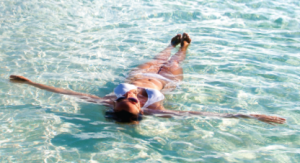Will my breast implants boil, melt, or keep me afloat?
By Joyce
 Summer officially arrives this Friday, June 21, which means it’s time to tan, swim, dive, sunbathe and unveil your new bikini. If you are also unveiling a new set of ta-tas, it’s time to get answers to some pressing questions like these:
Summer officially arrives this Friday, June 21, which means it’s time to tan, swim, dive, sunbathe and unveil your new bikini. If you are also unveiling a new set of ta-tas, it’s time to get answers to some pressing questions like these:
When can I go tanning?
You can start working on your tan as soon as three weeks after your breast augmentation surgery, but be sure to protect your incisions with sunscreen that has a sun protection factor (SPF) of 15 or higher. Ultraviolet light, whether from the tanning bed or the sun at the beach, can make a scar redder for a longer period of time.
Will my implants cook in a tanning bed?
If you want to get a tan before you head to the beach, you can go to a tanning salon without worry. Tanning salons use ultraviolet rays, which don’t cook anything. They don’t use microwaves, even though some people think they do. This was proved by a 2005 episode of MythBusters when the crew placed two raw chickens in a tanning bed for one hour. The skin got a little darker, but the chickens were still raw inside.
Will my breast implants keep me afloat in the ocean?
 Don’t count on it. Here’s why: Most people are neutrally buoyant, which means they don’t float up or down; they hover. More fat makes you float; more muscle makes you sink. It is gravity that eventually pulls you down.
Don’t count on it. Here’s why: Most people are neutrally buoyant, which means they don’t float up or down; they hover. More fat makes you float; more muscle makes you sink. It is gravity that eventually pulls you down.
Saline breast implants are filled with salt water in about the same density as the ocean water you are swimming in, so they are neutrally buoyant, too. You will float more easily in the ocean than in a pool because salt water is heavier than fresh water, but the same basic principles apply.
Silicone gel implants are slightly denser than water. Although they won’t make you sink, you might have to doggie paddle just a little bit harder. That’s why it is recommended that after getting silicone gel implants, a scuba diver does a checkout dive to see if she needs to adjust her dive weights.
Will scuba diving harm my breast implants?
A research team at Duke University Medical Center placed silicone gel and saline implants in a hyperbaric chamber to simulate the pressure experienced by scuba divers at various depths. When a diver is underwater, the increased pressure causes nitrogen, a component of the air we breathe, to build up in the blood and body tissues. If a diver surfaces too quickly, the nitrogen gas can form dangerous bubbles, similar to the bubbles you see when you first open a bottle of soda.

The moon jelly, a species of jellyfish, is round, translucent and gelatinous. That’s why, when it washes ashore, it’s easily mistaken for a silicone breast implant.
So what happened to the breast implants? The medical experts at DAN, the Divers Alert Network, summarized the findings on their website: “The bubbles that formed in the implants led to a small volume increase, which is not likely to damage the implants or surrounding tissues. If gas bubbles do form in the implant, they resolve over time.” No implants were harmed in the study.
Do breast implants melt in a sauna or in the sun?
Implants have a silicone shell, which would melt at temperatures greater than 392 degrees Fahrenheit. A conventional sauna is typically between 150 and 190 degrees. Unless you are sunbathing on the sun, you’ll be fine. If you are really worried, expose them only at dawn and dusk. See more on our video blog.
Can my implants boil in a hot tub?
Your implants are inside of your body, and you would have to boil the outside of your body before the inside boiled. The average hot tub temperature of 102 degrees Fahrenheit isn’t hot enough to do that.
Nuff said. Have a great summer. And if you find some men staring at your cleavage, remind them of what Jerry Seinfeld had to say: “Looking at cleavage is like looking at the sun. You can’t stare at it. It’s too risky. You get a sense of it and then you look away.”
